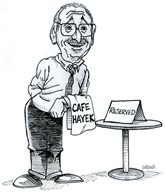Today’s events are a stark lesson that there is no common ground to be had [for classical liberals, libertarians, or free-market conservatives] with the “postliberal” right.
It is avowedly anti-capitalist and its doctrines embrace the centralized planning of the economy by government.
All details aren’t clear as we write this, but Mr. Trump’s tariffs look “reciprocal” in name only. First he’s hitting every nation in the world with a 10% “baseline” tariff to sell in the U.S. market. For those he calls “bad actors,” he’s adding up the country’s tariff rate on U.S. goods, plus an arbitrary estimate of the cost of its “currency manipulation” and non-tariff barriers. He then takes that total number and applies half of that in tariffs on the country’s exports to the U.S.
…..
There will certainly be higher costs for American consumers and businesses. Tariffs are taxes, and when you tax something you get less of it. Car prices will rise by thousands of dollars, including those made in America. Mr. Trump is making a deliberate decision to transfer wealth from consumers to businesses and workers protected from competition behind high tariff walls.
Over time this will mean the gradual erosion of U.S. competitiveness. Tariffs that blunt competition invite monopoly profits while reducing the need to innovate. This is the story of the American steel and car industries in the 1950s and 1960s before global competition exposed their deficiencies.
…..
The cost in lost American influence will be considerable. Mr. Trump thinks the lure of the U.S. market and American military power are enough to bend countries to his will. But soft power also matters, and that includes being able to trust America’s word as a reliable ally and trading partner. Mr. Trump is shattering that trust as he punishes allies and blows up the USMCA that he negotiated in his first term.
• A major opportunity for China. The great irony of Mr. Trump’s tariffs is that he justifies them in part as a diplomatic tool against China. Yet in his first term Mr. Trump abandoned the Asia-Pacific trade deal that excluded China. Beijing has since struck its own deal with many of those countries.
Mr. Trump’s new tariff onslaught is giving China another opening to use its large market to court American allies. South Korea and Japan are the first targets, but Europe is on China’s list. Closer trade ties with China, amid doubts about access to the U.S. market, will make these countries less likely to join the U.S. to impose export controls on technology to China or to ban the next Huawei.
Oh, and I have a question for those of you who claim that an easy and good way for Americans to avoid paying U.S. tariffs is to “buy American” and produce more things here at home: If your town managed to impose tariffs on groceries sold at your supermarket, would you think, “No problem! I can escape these higher prices simply by raising my own chickens, growing my own wheat, and manufacturing my own toilet tissue. I’ll have more employment and be richer!”?
Phil Magness’s letter in today’s Wall Street Journal is superb:
In his op-ed “The Case for Tariffs” (March 31), John Michaelson claims that “America thrived with a high-tariff regime in the 19th and early 20th centuries.” He appends a further defense of the Smoot-Hawley Tariff of 1930 by describing it as “high but not exceptional” and unlinked to the Great Depression.
Both assertions are hoary old myths from the protectionist lobby. On the first claim, economic historians have long documented that the strongest industrial growth in the 19th-century U.S. took place in nontraded and nonprotected sectors such as transportation, utilities and communication. By contrast, tariffs in that era became a magnet for Gilded Age corruption at the behest of “infant industries” that never grew up despite the immense public benefits they received.
As for Smoot-Hawley, this protectionist measure imposed an average rate of 59%, placing it well above most 19th-century tariffs and some 20 percentage points higher than its protectionist predecessor, the Fordney-McCumber tariff of 1922. While it didn’t cause the 1929 crash, the levy advanced through Congress as a “stimulus” measure predicated on the same protectionist theories that Mr. Michaelson advocates today. In practice, it collapsed global trade and helped transform the nascent recession into a decadelong global depression. Let’s not repeat these well-documented mistakes.
Also from Phil Magness is this gem titled “Trade Freedom and the Myth of Tariff Reciprocity.” A slice:
In the White House’s telling, these new tariffs “will bring back fairness and prosperity to the distorted international trade system and stop Americans from being taken advantage of.” Trump describes his measures as “reciprocal” and claims they are only necessary because other countries apply even more egregious tariff and non-tariff barriers (NTBs) to American goods on the international market. As Trump himself recently put it when justifying his tariffs on Canada, “We’ve been ripped off for years and we won’t be ripped off anymore.”
There’s a problem with the White House’s tariff justification, though: it’s a complete myth.
The United States is currently one of the worst offenders among developed nations in placing discriminatory tariffs and NTBs on our trading partners. This ignominious position may be seen in the Heritage Foundation’s Index of Economic Freedom, which compiles an annual “trade freedom” score for nearly 200 countries and political jurisdictions. According to the 2025 report, the United States ranks in 69th place, putting us lower than New Zealand (2nd), Australia (3rd), the United Kingdom (17th), Canada (18th), France (38th), and Germany (39th).
Eric Boehm is correct: “America is losing Trump’s trade war to itself.” A slice:
Much of the chaos Trump has unleashed speaks to a bigger problem: Trump’s theory of how to use tariffs is deeply illogical, even once you get past the economic illiteracy. It is worthwhile to think through those arguments, if only because they are likely to resurface as justifications for tariffs in other contexts over the coming years.
Trump loves to claim that tariffs will make America a wealthier nation. “The tariffs are going to make us very rich and very strong,” Trump said in late January, just before launching (and then pausing) his North American trade war. “They don’t cause inflation. They cause success.” He’s used variations of this line for years, and on the campaign trail in 2024 he would often claim that America was at its peak during the 1890s, when tariffs were significantly higher than they are today.
That’s nonsense. Americans are far wealthier today than in the 1890s, when most people did not have access to indoor plumbing, electricity, or modern medical care, and when the average hourly wage was less than 14 cents—that’s less than $5 today when adjusted for inflation.
After Trump’s “Liberation Day” tariff announcement, David Henderson concludes:
Although it would be an exaggeration, I’m tempted to say of everything that follows Trump’s correct point that you need to consider non-tariff barriers, something similar to what author Mary McCarthy said of Communist writer Lillian Hellman: Every word she writes is a lie, including “and” and “the.”



